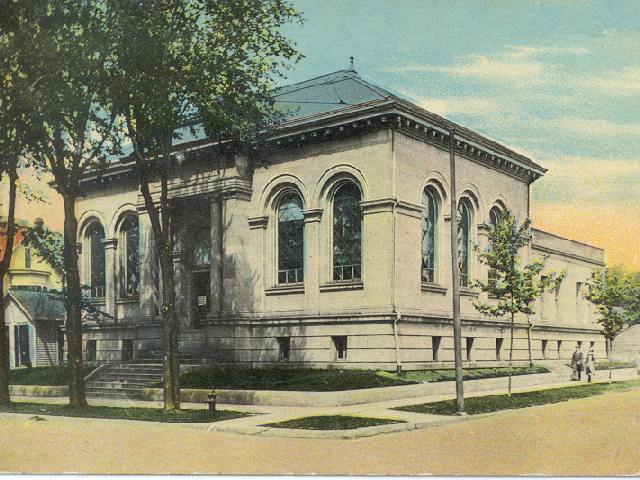Crawfordsville
History of Crawfordsville

Crawfordsville History
Before white people came to the area that later became Montgomery County and Crawfordsville, the land was inhabited by several tribes of Indians scattered all over the county. The tribes included the Piankeshaws, the Miamis, the Potawatomis and the Shawnees. The first Europeans in the area were French traders who traveled along Sugar Creek and missionaries who came to convert the Indians.
During the War of 1812, American Ranger units patrolled the frontier to keep the Indians under observation and control since many tribes sided with the British in the war. In 1813, when the county was still Indian territory, Major Ambrose Whitlock, Captain Williamson Dunn and Lieutenant Henry Ristine came with a company of Rangers. The area was densely wooded on the southern end of the county. The abundant oak, poplar, walnut, sugar maple, and sycamore thinned out on the northern area, giving way to a fertile, gently rolling prairie. Shale and clay were visible on the bluffs and bank of many streams. The fish and game were plentiful. They agreed that the land bordering Sugar Creek would be a good site for a settlement. It was nearly 10 years before the three officers and thirteen privates returned with their families. William Miller had already built the first cabin, locating it on the bluff along Sugar Creek. In the spring of 1823, Ristine built the second.
By 1818 the United States signed the Treaty of St. Mary's, also called the New Purchase, buying this area of Central Indiana from the Indians. On December 21, 1822, the Indiana General Assembly voted to organize Montgomery County. The county was named in honor of a Revolutionary War hero, General Richard Montgomery. In 1823, the Federal Land Office was moved to the area now called Crawfordsville from Terre Haute. Williamson Dunn was the Registrar and Ambrose Whitlock the Receiver and the head of the Land Office. The city was named by Whitlock after William Crawford, who was a prominent politician of the time, and appointed Whitlock to his position in the Land Office.
Many of the early settlers to the area came from Kentucky, Virginia, North Carolina, and Ohio. There were many reasons for the settlers to move to the area including bountiful farm ground, water-powered saw mills along Sugar Creek, and the settlers were able to purchase a clear deed to land. Many states during that time did not provide a "clear title" to the land and often the early settlers were plagued by litigation.
Crawfordsville's growth in the nineteenth century came from its position as the county seat. Railroads, the horse business, and access to higher education became a major factor in the growth of the area by 1853. The Monon Railroad was established. Several other lines were built through the area making Crawfordsville a hub for commerce and transportation. By the end of the century, it was the financial and trading center of the surrounding rich agricultural region and it was undergoing industrial development. With the improved transportation, commerce began to flourish. The city had woolen mills, tanneries, carriage and wagon making tile and brick factories, marble cutting, machine shops, furniture making and meat packing. Wabash College was established in 1832. Wabash College was one of the earliest all-male schools of higher education in the Mid-West. Wabash College remains unique today because it remains an all male institution. By 1875 Crawfordsville had gas lights. By 1882, the city had telephones, and by 1890, a municipally owned electric plant.
Although Crawfordsville continues its steady growth today and is a modern third class city, you would easily find it proud of its history. The Henry S. Lane Mansion and the Lew Wallace Study still stands and is open for the public to tour. Many of the county's celebrated covered bridges can be seen, and the only operational rotating jailhouse in the country is located on the north end of the city.
Crawfordsville population of 14,288 continues to prosper. The average age in the community is 37.5 years of age. The unemployment rate is 3.1%. The city has three major state highways, which intersect in the community, and Interstate 74 flows past the city just to the north. Industry remains very strong and diverse in Crawfordsville. Its major employers include RR Donnelly and Sons (Printing & Publishing), Raybestos Products (Automotive), Lithonia/Hi-Tek (Electrical Lighting Fixtures), Nucor Steel (Rolled Steel), Pace Dairy (Food Products), and St. Clare Medical Center (Hospital). The city still acts as an economic hub for the west central Indiana area. In fact, the community is a net importer of jobs from a sixty mile radius.
From an educational perspective, the county has three school systems including Crawfordsville, North Montgomery, and South Montgomery. As mentioned previously, Wabash College is located in Crawfordsville and DePauw University and Purdue University are within a thirty minute drive from the city.
Crawfordsville and Montgomery County is bustling all year long with festivals and sporting events including the Strawberry Festival in May, the Covered Bridge Festival, several ASA qualifier softball tournaments just to name a few. In closing, Crawfordsville is an outstanding place to live and raise a family. Crawfordsville is full of quite tree lined street and neighborhoods, low crime rates and strong family values. But don't just take our word for it! You can read about the community in Norman Crampton's book "The 100 best small towns in America." Norman rated Crawfordsville number forty-third.
Adapted from "Montgomery County: Focus on Government and Other Services" published by the Montgomery County League of Women Voters, 1998


